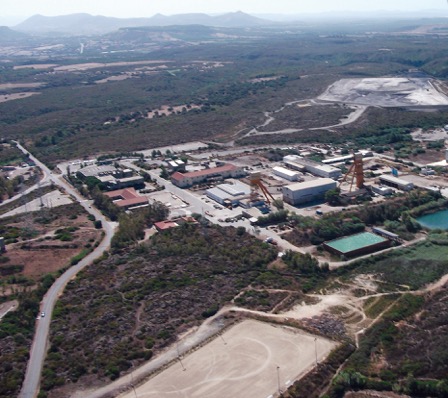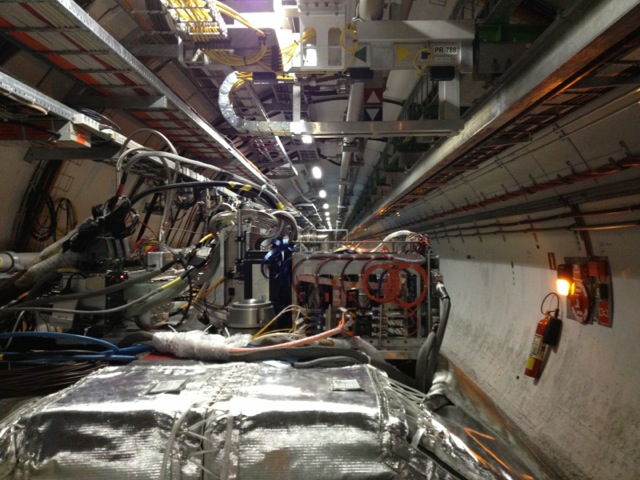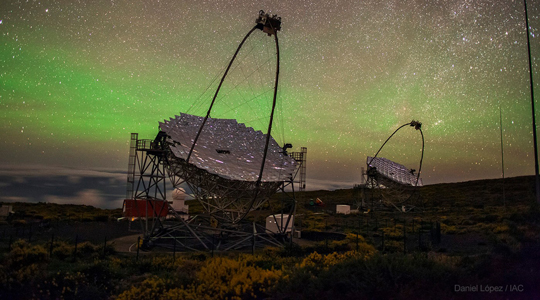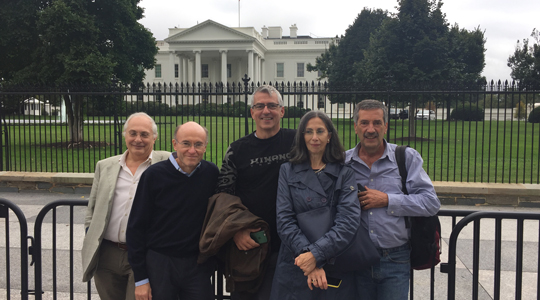 November 15th 2016 - Antonio Masiero, deputy head of INFN in Italy and professor of theoretical physics at the University of Padua has been appointed by the APPEC General Assembly as the new Chair of the APPEC organisation commencing in January 2017.
November 15th 2016 - Antonio Masiero, deputy head of INFN in Italy and professor of theoretical physics at the University of Padua has been appointed by the APPEC General Assembly as the new Chair of the APPEC organisation commencing in January 2017.
Professor Masiero was elected Chair of APPEC (Astroparticle Physics European Consortium) by representatives of the 13 member countries of the group which coordinates research in Astroparticle Physics in Europe.
At the same General Assembly Job de Kleuver, from the Dutch FOM Institute for International Affairs and Large Scale Facilities, was elected Secretary General. Both will take office on 1 January 2017, respectively succeeding Professor Frank Linde (Nikhef, Netherlands) and Thomas Berghöfer (DESY, Germany), at the end of their mandates.
Speaking of his appointment Professor Masiero said “"It is really an honour and a responsibility to be asked to lead APPEC through the next few years when we will be putting in place the key recommendations made by the forthcoming APPEC road map due to be published early in 2017. Astroparticle physics now represents an extraordinarily exciting opportunity for science to explore the uncharted land beyond the Standard Models of particle physics and cosmology".
Current APPEC Chair Professor Linde welcomed the appointments and said “Congratulations to Antonio on being appointed APPEC Chair. You will have a busy time ahead of you with the roadmap soon to be published. I am sure you will do an excellent job as our new APPEC Chair.”
Job de Kleuver said "Astro particle physics is an exciting field of science and in recent months we have seen research breakthroughs with hopefully more on their way. The implementation of the new APPEC roadmap is an ambitious effort and I am fully motivated to take on responsibility for those plans, together with Antonio, and to strengthen the ties between the APPEC partners, leading to both the realisation of new research infrastructures and enabling European Astroparticle Physics to continue to flourish."
Appec is the consortium that brings together European agencies that support research in Astroparticle Physics at the national level, with the primary objective to promote and facilitate cooperation within the growing community of astroparticle physicists in Europe. Astroparticle physics, that the encounter between particle physics, cosmology and Astrophysics, is a relatively recent and rapidly growing field of research. With physics experiments in the underground Labs and submarines, extensive networks of ground-based telescopes to detectors in space, Europe is gathering more and more fascinating challenges, aiming to study the elusive particles and uncover the darkest mysteries about the structure of the universe.
Biographies
Antonio Masiero was born in Vicenza in 1955 and since 2001 he has been Professor of physics at the University of Padua and was Director of the local chapter of INFN. A graduate of the University of Padua in 1978 (with a thesis on the unification of the fundamental interactions), he spent eight years of research abroad (postdoc at the University of Geneva, CERN and at the Max Planck Institut Munich, assistant professor at New York University) in the period 1979-1987. His research career began at INFN in 1982 at the INFN Padova and later a senior researcher in the same section in 1987. He has been a college professor since 1994, first as extraordinary Professor at the University of Perugia, then to SISSA (international school for advanced studies) in Trieste and then at the University of Padua. His research has shown particular attention to signs of new physics beyond the Standard model. Antonio is author of about 200 scientific publications and he has been an invited speaker at more than 100 conferences and international schools.
Job de Kleuver graduated in experimental physics in 1989. After two years of research in physics, in 1991 he moved to Research Policy Department of FOM, the Research Council in the Netherlands. He is currently responsible in charge of International Affairs and large infrastructures. For 25 years, he has been involved in scientific policy in various fields of physics, with a specific focus on large research infrastructures, such as the Dutch laboratory experiments at LHC HFML and since 2000 astroparticle physics. He is Secretary of the board of the collaboration Nikhef and a member of various committees including HFML domestic, international and European projects.
 The Italian Interministerial Committee on Economic Planning (CIPE) has approved funding for nine research projects considered to be of "strategic importance", one of which is the INFN's ARIA project. The projects will be funded through the Special Fund for Research (FISR). Led by the INFN with the collaboration of Princeton University (USA) and Sardinia Regional Council through Carbosulcis S.p.A., ARIA will lead to the construction of an innovative research infrastructure in Sardinia, in the Monte Sinni mine in the Sulcis coalfield area. The aim of the project is to separate the atmosphere into its fundamental components to obtain elements that can be used in various areas of research and technology. One of these components, argon-40, is an extremely precious material that will be used in the DarkSide experiment to develop an innovative system for studying dark matter at the INFN's Gran Sasso National Laboratories (LNGS).
The Italian Interministerial Committee on Economic Planning (CIPE) has approved funding for nine research projects considered to be of "strategic importance", one of which is the INFN's ARIA project. The projects will be funded through the Special Fund for Research (FISR). Led by the INFN with the collaboration of Princeton University (USA) and Sardinia Regional Council through Carbosulcis S.p.A., ARIA will lead to the construction of an innovative research infrastructure in Sardinia, in the Monte Sinni mine in the Sulcis coalfield area. The aim of the project is to separate the atmosphere into its fundamental components to obtain elements that can be used in various areas of research and technology. One of these components, argon-40, is an extremely precious material that will be used in the DarkSide experiment to develop an innovative system for studying dark matter at the INFN's Gran Sasso National Laboratories (LNGS).



 Following successful completion, in the course of last week, of re-installation of the detector in the LHC tunnel, on 25 November the
Following successful completion, in the course of last week, of re-installation of the detector in the LHC tunnel, on 25 November the  After seven billion years, the photons emitted by the galaxy "QSO B0218+357", which is home to a supermassive black hole, have reached the Earth. Observing the most distant source of gamma rays ever observed at high energy were the Fermi-LAT (Large Area Telescope) space telescope and the two MAGIC (Major Atmospheric Gamma-ray Imaging Cherenkov) ground-based telescopes, in the Canary islands, which were alerted by Fermi-LAT. Due to the full moon, however, whose light overshadowed the signal, the large MAGIC mirrors were not able to immediately observe the emission of the ultra-energetic photons. The observation was again possible 11 days after the signal recorded by Fermi-LAT, thanks to the gravitational lensing effect (Einstein lens). The phenomenon, due to the presence of a second nearer galaxy, caused the separation of the light into two different paths, with a delay between the two signals which, calculated based on the General Relativity predictions, corresponds exactly to the 11 days actually experienced. The correspondence is of great interest and indicates that the structure of the cosmic void is that predicted by the theories, with particular reference to the number of background photons, approx. one hundred per cubic centimetre. The observation also shows that the gravitational lensing effect does depend on the wavelength of the photons..
After seven billion years, the photons emitted by the galaxy "QSO B0218+357", which is home to a supermassive black hole, have reached the Earth. Observing the most distant source of gamma rays ever observed at high energy were the Fermi-LAT (Large Area Telescope) space telescope and the two MAGIC (Major Atmospheric Gamma-ray Imaging Cherenkov) ground-based telescopes, in the Canary islands, which were alerted by Fermi-LAT. Due to the full moon, however, whose light overshadowed the signal, the large MAGIC mirrors were not able to immediately observe the emission of the ultra-energetic photons. The observation was again possible 11 days after the signal recorded by Fermi-LAT, thanks to the gravitational lensing effect (Einstein lens). The phenomenon, due to the presence of a second nearer galaxy, caused the separation of the light into two different paths, with a delay between the two signals which, calculated based on the General Relativity predictions, corresponds exactly to the 11 days actually experienced. The correspondence is of great interest and indicates that the structure of the cosmic void is that predicted by the theories, with particular reference to the number of background photons, approx. one hundred per cubic centimetre. The observation also shows that the gravitational lensing effect does depend on the wavelength of the photons.. November 15th 2016 - Antonio Masiero, deputy head of INFN in Italy and professor of theoretical physics at the University of Padua has been appointed by the APPEC General Assembly as the new Chair of the APPEC organisation commencing in January 2017.
November 15th 2016 - Antonio Masiero, deputy head of INFN in Italy and professor of theoretical physics at the University of Padua has been appointed by the APPEC General Assembly as the new Chair of the APPEC organisation commencing in January 2017. On 3rd and 4thOctober, the bilateral meeting for scientific cooperation between INFN, represented by the President, Fernando Ferroni, and by the Executive Committee, the Department Of Energy (DOE) and the National Science Foundation (NSF) was held in Washington. The meeting provided the opportunity to discuss in detail and in an informal manner research activities involving the collaboration between Italian and US physicists. In this edition, the topics addressed were: neutrino physics at Fermilab and, in particular, the Icarus project, coordinated by Nobel laureate Carlo Rubbia; the collaboration between Virgo and LIGO in the study of gravitational waves and the future prospects with surface, underground and space detectors; the experiments based at the INFN Gran Sasso National Laboratory (LNGS) with US participation, in particular for the search for dark matter and for neutrinoless double beta decay; LHC and computing; research in the nuclear physics field and, in particular, the collaboration with the Jefferson Laboratory.
On 3rd and 4thOctober, the bilateral meeting for scientific cooperation between INFN, represented by the President, Fernando Ferroni, and by the Executive Committee, the Department Of Energy (DOE) and the National Science Foundation (NSF) was held in Washington. The meeting provided the opportunity to discuss in detail and in an informal manner research activities involving the collaboration between Italian and US physicists. In this edition, the topics addressed were: neutrino physics at Fermilab and, in particular, the Icarus project, coordinated by Nobel laureate Carlo Rubbia; the collaboration between Virgo and LIGO in the study of gravitational waves and the future prospects with surface, underground and space detectors; the experiments based at the INFN Gran Sasso National Laboratory (LNGS) with US participation, in particular for the search for dark matter and for neutrinoless double beta decay; LHC and computing; research in the nuclear physics field and, in particular, the collaboration with the Jefferson Laboratory. 

